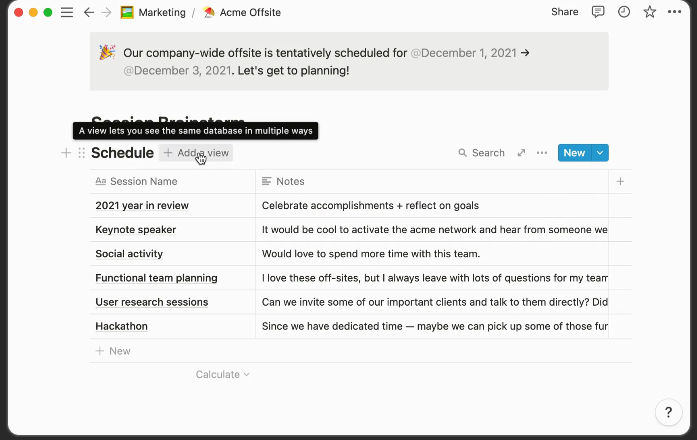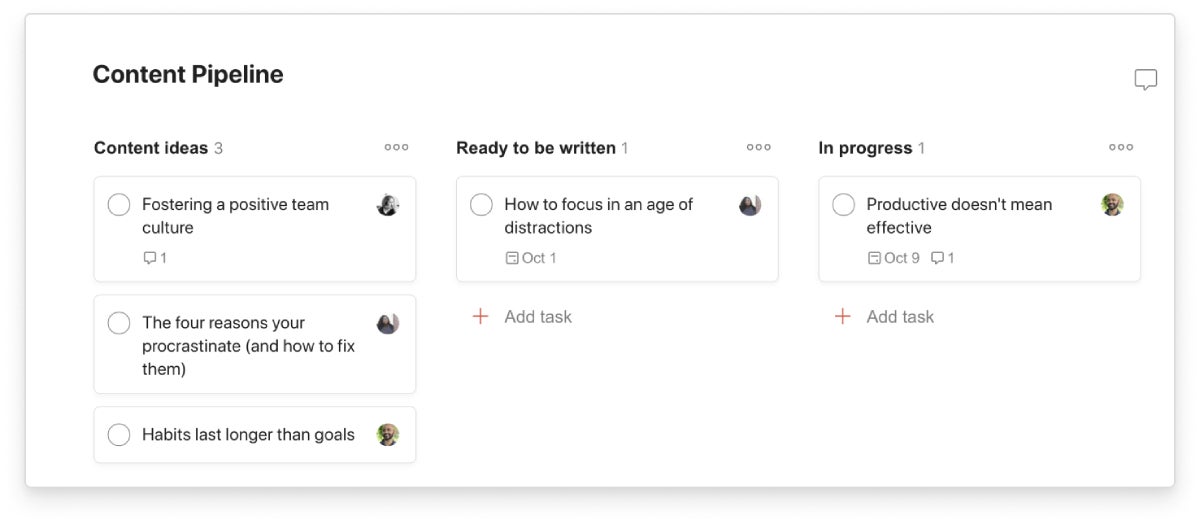With the plethora of productivity and task management apps available, it can be overwhelming to choose the right tool for your needs. Notion and Todoist are among the best apps for task management, note-taking and basic project management. In this Notion vs. Todoist comparison, we highlight the top use cases, pricing, pros and cons of each software. We also compare some of the core features of the software and share some advice on which tool is the right one for you.
Jump to:
- What is Notion?
- What is Todoist?
- Notion vs. Todoist: Comparison table
- Notion and Todoist pricing
- Feature comparison: Notion vs. Todoist
- Notion pros and cons
- Todoist pros and cons
- Best use cases for Notion
- Best use cases for Todoist
- Methodology
- Should your organization use Notion or Todoist?
What is Notion?

Founded in 2013, Notion was launched as a note-taking application but has become an all-in-one project management solution. It is highly versatile software offering a variety of features, including note-taking capabilities, productivity tools and task assignment. You can also personalize your workspace according to your needs. You can learn more in our full Notion review.
What is Todoist?

Todoist is primarily a task management software solution used to create custom schedules and to-do lists and track progress. You can use the software for individual use or as a collaborative tool. The interface is clean and organized, making Todoist easy to use. To learn more, you can check out our full Todoist review.
Notion vs. Todoist: Comparison table
| Features | Notion | Todoist |
|---|---|---|
| Prebuilt templates | Yes | Limited |
| Native Gantt charts | No | No |
| Task management | Yes | Yes |
| Mobile app | iOS and Android | iOS and Android |
| Note-taking tools | Yes | Limited |
| Task dependencies | Yes | No |
| Free version | Available | Available |
| Free trial | 7-90 days, depending on the plan | 30 days |
| Starting price | $8 per user per month | $4 per user per month |
Featured partners
Notion and Todoist pricing
Notion pricing
Free
The Free plan offers unlimited blocks for individuals but limited blocks for teams. You get to invite up to 10 guests and have access to the seven-day page history. In addition, users get basic page analytics, a collaborative workspace and a few basic integrations.
Plus
The Plus plan, formerly known as the Team plan, is priced at $8 per user per month if billed annually or $10 per user per month if billed monthly. You unlock unlimited blocks for teams, can invite up to 100 guests and gain access to a 30-day page history.
Business
The Business plan is priced at $15 per user per month if billed annually or $18 per user per month if billed monthly. You get everything in the Plus plan, in addition to extra guests, longer page history, advanced page analytics, bulk data export and private team spaces.
Enterprise
The Enterprise plan has customized pricing. For the features, you get everything in the Business plan plus user provisioning (SCIM), custom guest limits, audit logs, a dedicated success manager and several other advanced project management tools.
Todoist pricing
Beginner
This free plan is designed for starters. You get a maximum of five active projects. In addition, you get 5 MB file uploads, a one-week activity log and three filter views.
Pro
The Pro plan is priced at $4 per user per month if billed annually or $5 per user per month billed monthly. This plan gives 300 active projects, unlimited filter views, 100 MB file uploads and unlimited activity history.
Business
The Business plan is priced at $6 per user per month if billed annually or $8 per user per month if billed monthly. You get all the features of the Pro plan plus team invoicing, team inbox, admin and member roles and up to 500 active projects per member.
Feature comparison: Notion vs. Todoist
Note-taking
Notion offers specialized note-taking tools (Figure C) that are lacking in Todoist. These include the ability to create custom tables and databases, a wider range of formatting options and media embedding tools. With Notion, you can also create a hierarchical structure with the notes by adding subpages and sections. Todoist offers basic note-taking tools designed to provide context for specific tasks. This is a useful feature for team collaboration. You do have the option of integrating with different third-party note-taking apps to extend Todoist’s functionality.
Figure C

Task management
Both Notion and Todoist have excellent task management capabilities. You can create and organize tasks, set reminders, set up recurring tasks and track task progress. While Todoist is geared more toward individual use, it does offer a variety of collaboration tools for task management. If you need simplicity and efficiency in task management, Todoist would be a better choice. However, if you need more customization and flexibility in how you want to use the tools, then Notion would be a better choice.
Multiple project views
While Notion and Todoist offer a variety of project views (Figure D), you don’t get the same level of detail or functionality as some of the more specialized project management applications. For example, Notion and Todoist don’t offer native Gantt charts. Both software offer templates and add-ons for project views (Figure D), but these only offer basic functionality that might not be enough for managing complex projects or a project portfolio.
Figure D

Prebuilt templates
Prebuilt templates provide a starting point for managing a project or creating a task list. With Notion, you get a wider variety of prebuilt templates. The templates offered by Notion are also more customizable. With Todoist, the pre-built templates are simpler and are geared toward creating and managing tasks. Users who want a quick task list setup would enjoy using Todoist more. However, for more diverse and customizable templates, Notion is a better choice.
Notion pros and cons
Pros of Notion
- Intuitive and user-friendly UI.
- Specialized note-taking capabilities.
- Outstanding workspace customization.
- Variety of prebuilt templates.
Cons of Notion
- Light on reporting and analytics.
- Limited security features.
Todoist pros and cons
Pros of Todoist
- Clean and efficient interface.
- Cross-platform automatic syncing.
- Natural language support.
- Low starting price.
Cons of Todoist
- Free plan lacks basic features such as auto backup.
- Frequent price changes.
- Not suitable for complex projects.
Best use cases for Notion
- Basic task management.
- Note-taking.
- Content creation and creative work.
- Creating project roadmaps.
- Creating and managing documentation.
Best use cases for Todoist
- Basic task management.
- Research.
- Personal productivity.
- Event planning.
- Goal tracking.
Methodology
To review Notion and Todoist, we did a hands-on review of the software to understand the usability and functionality of the software. Our evaluation criteria included different aspects of the software, including pricing and value for money, user interface, integration capabilities and more. We also checked customer reviews and ratings from several reputed sources.
Should your organization use Notion or Todoist?
The decision to choose Notion or Todoist will depend on several factors, including your priorities and primary use cases. Notion offers more comprehensive task management, note-taking and productivity features and a wide range of prebuilt templates.
If you need simplicity, then Todoist would be a better choice. Both applications are suitable for small businesses, freelancers and startups. Smaller teams and individuals in larger organizations can also benefit from using either software. Fortunately, Notion and Todoist offer free versions and free trials, so you can familiarize yourself with the software before making a final decision.
If you find Notion and Todoist do not meet your requirements, you can consider alternatives. We offer a comparison review of Notion vs. Asana, Trello and Coda. We have also compiled a list of the top Todoist alternatives and offer comparison reviews for Todoist vs. Trello and Asana.
Featured partners
1 Jira
Simple and powerful way to track and manage issues. It handles all kinds of issues (bugs, features, enhancements, and tasks) and can be used for bug tracking, development help, project management, or group task cataloging.
2 Trello
Organize anything, together. Trello is a collaboration tool that organizes your projects into boards. In one glance, know what's being worked on, who's working on what, and where something is in a process.










